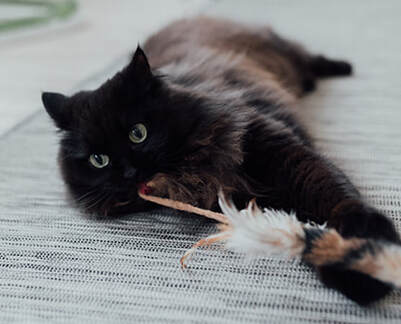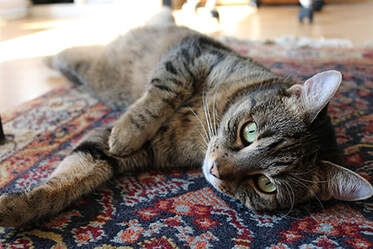 Photo by Arina Krasnikova from Pexels
Photo by Arina Krasnikova from Pexels Although your senior cat may now spend more time lounging and less time playing, she still needs activities to keep her both mentally and physically fit. Could YOU be missing her cue that she’s simply waiting for YOU to take the lead? If so, consider the following to help her release her remembered inner kitten.
If your favorite feline recognizes the images of various animals on TV, she may truly enjoy watching videos of birds, squirrels and other wildlife that have been created expressly for cats. Alternatively, place her cat tree close to a window where she can watch the world or set up a bird feeder outside and place her cat tree near the window facing it.
Because she’s less athletic and agile now than when she was young, ensure that the toys you use to keep her active don’t aggravate such common conditions in the aging as arthritis. Among the best “lower-activity toys” are:
• Cardboard boxes: Cut numerous openings into the sides of several cardboard boxes and place half of them right side up and the other half upside down, creating “cubbies” for her to enter and exit with ease.
• Climbing toys: If she doesn’t already have a cat tree, get her an especially sturdy one with several shelves that will allow her to climb up and down safely without having to leap any appreciable distance.
• Fleece pulls and toys: From something as simple as a soft, thick bathrobe pull to a wide assortment of fleece toys, they not only provide your kitty with something to chase and “capture”, they’re too large to be swallowed.
• Food-dispensing toys: Fill one of a variety of round, plastic food puzzles with high-value treats or kibble, and watch her roll it around and around in an effort to get out and eat her tasty “rewards.”
• Paper bags: Select a safe space in your home, open one or two large bags (grocery bags are best) and provide her with an inexpensive and instant hiding place or “cat cave.”
When interacting personally with your kitty using toys with a long ribbon or string, yarn or rubber band attached, remember that such long, tempting “tails” can be all too easily swallowed -- even by a senior – wreaking havoc with her stomach and intestines. Always store those toys safely out of sight as soon as playtime is done.
While catnip toys appeal to a majority of cats, some cats aren’t affected by it at all. If yours is one of them, keep your finicky senior feline on her toes by enticing her with toys filled with silver vine (the most popular), Tatarian honeysuckle or Valerian root instead.
Practice golf balls with the holes and ping pong balls make ideal toys -- both size and weight-wise -- for senior cats. Place several balls in an enclosed, safe space such as a bathtub and let your kitty have her way with them. You can also put a ball into an empty tissue box and allow her to fish around for it with her paws.
In short, while your senior kitty may not play as long or as hard as she did in her youth, it’s essential that you not only interact with her at least once a day but that you provide her with ample opportunities to stay engaged and amused on her own. What more paws-itive way could there be to keep her inner kitten alive and out there for all to see?










 RSS Feed
RSS Feed